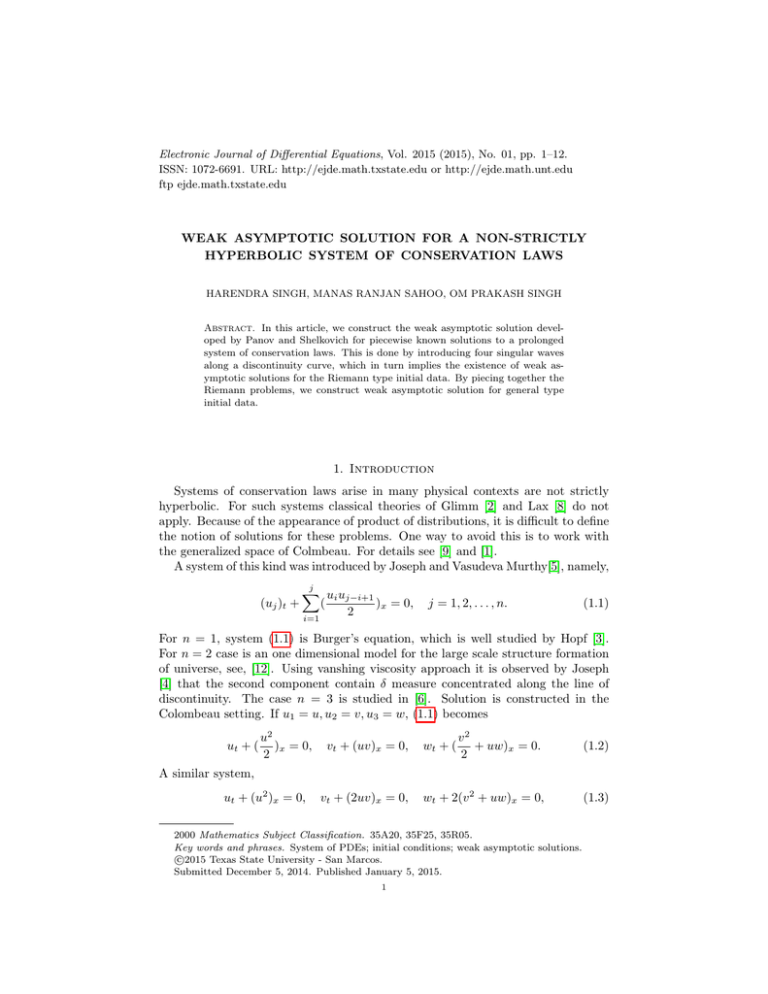Electronic Journal of Differential Equations, Vol. 2015 (2015), No. 01,... ISSN: 1072-6691. URL: or
advertisement

Electronic Journal of Differential Equations, Vol. 2015 (2015), No. 01, pp. 1–12.
ISSN: 1072-6691. URL: http://ejde.math.txstate.edu or http://ejde.math.unt.edu
ftp ejde.math.txstate.edu
WEAK ASYMPTOTIC SOLUTION FOR A NON-STRICTLY
HYPERBOLIC SYSTEM OF CONSERVATION LAWS
HARENDRA SINGH, MANAS RANJAN SAHOO, OM PRAKASH SINGH
Abstract. In this article, we construct the weak asymptotic solution developed by Panov and Shelkovich for piecewise known solutions to a prolonged
system of conservation laws. This is done by introducing four singular waves
along a discontinuity curve, which in turn implies the existence of weak asymptotic solutions for the Riemann type initial data. By piecing together the
Riemann problems, we construct weak asymptotic solution for general type
initial data.
1. Introduction
Systems of conservation laws arise in many physical contexts are not strictly
hyperbolic. For such systems classical theories of Glimm [2] and Lax [8] do not
apply. Because of the appearance of product of distributions, it is difficult to define
the notion of solutions for these problems. One way to avoid this is to work with
the generalized space of Colmbeau. For details see [9] and [1].
A system of this kind was introduced by Joseph and Vasudeva Murthy[5], namely,
(uj )t +
j
X
ui uj−i+1
(
)x = 0,
2
i=1
j = 1, 2, . . . , n.
(1.1)
For n = 1, system (1.1) is Burger’s equation, which is well studied by Hopf [3].
For n = 2 case is an one dimensional model for the large scale structure formation
of universe, see, [12]. Using vanshing viscosity approach it is observed by Joseph
[4] that the second component contain δ measure concentrated along the line of
discontinuity. The case n = 3 is studied in [6]. Solution is constructed in the
Colombeau setting. If u1 = u, u2 = v, u3 = w, (1.1) becomes
ut + (
u2
)x = 0,
2
vt + (uv)x = 0,
v2
+ uw)x = 0.
2
(1.2)
wt + 2(v 2 + uw)x = 0,
(1.3)
wt + (
A similar system,
ut + (u2 )x = 0,
vt + (2uv)x = 0,
2000 Mathematics Subject Classification. 35A20, 35F25, 35R05.
Key words and phrases. System of PDEs; initial conditions; weak asymptotic solutions.
c
2015
Texas State University - San Marcos.
Submitted December 5, 2014. Published January 5, 2015.
1
2
H. SINGH, M. R. SAHOO, O. P. SINGH
EJDE-2015/01
is studied by Panov and Shelkovich [11]. In [11] a concept of weak asymptotic solution is introduced and a solution is constructed under this consideration and generalized integral formulation is introduced for piecewise continuous data. Note that
the system (1.3) can be obtained from (1.2) using the transformation (u, v, w) →
(2u, v, w2 ). The case n = 4 is studied by joseph and Sahoo [7]. In [7], using vanshing viscosity approach a solution is constructed for Riemann type initial data and
based on this a weak integral formulation is given.
In this paper we use the weak asymptotic method introduced by Panov and
Shelkovich [11] to study the case n = 4. Putting u1 = u, u2 = v, u3 = w, u4 = z
and followed by a linear transformation, the system (1.1) leads to the system
ut + (u2 )x = 0,
2
wt + 2(v + uw)x = 0,
vt + (2uv)x = 0
zt + 2((3vw + uz)x ) = 0.
(1.4)
The aim of this paper is to study the above system (1.4) with initial conditions
u(x, 0) = u0 (x),
v(x, 0) = v0 (x),
w(x, 0) = w0 (x),
z(x, 0) = z0 (x).
(1.5)
The content of the paper is as follows. We construct weak asymptotic solution by
connecting two known solutions from the left and right. As a special case we derive
weak asymptotic solution for the Riemann type initial data. Then we construct
a weak asymptotic solution when the initial data for u is a monotonic increasing
function and initial data for v, w and z are locally integrable functions.
2. weak asymptotic solution for Riemann type initial data
In this section we connect two classical solutions by introducing a discontinuity
curve in asymptote level. First of all we recall the definition of weak asymptotic
solution as introduced in [11, 10].
Definition 2.1. Let us define
L1 (u) = ut + (u2 )x ,
2
L3 (u, v, w) = wt + 2(v + uw)x ,
L2 (u, v) = vt + (2uv)x
L4 (u, v, w, z) = zt + 2((3vw + uz)x ).
(u , v , w , z ) is said to be weak asymptotic solution to problem (1.4) with initial
data (1.5) if
Z
L1 [u(x, t, )]ψ(x)dx = o(1),
Z
L2 [u(x, t, ), v(x, t, )]ψ(x)dx = o(1),
(2.1)
Z
L3 [u(x, t, ), v(x, t, ), w(x, t, )]ψ(x)dx = o(1),
Z
L4 [u(x, t, ), v(x, t, ), w(x, t, ), z(x, t, )]ψ(x)dx = o(1),
EJDE-2015/01
WEAK ASYMPTOTIC SOLUTION
3
and initial conditions satisfy
Z u(x, 0, ) − u0 (x) ψ(x)dx = o(1),
Z v(x, 0, ) − v0 (x) ψ(x)dx = o(1),
Z w(x, 0, ) − w0 (x) ψ(x)dx = o(1),
Z z(x, 0, ) − z0 (x) ψ(x)dx = o(1),
(2.2)
for all ψ ∈ D(R).
To study weak asymptotic analysis first we need the following Lemma as in [11],
regarding the superpositions of the singular waves δ, δ 0 , δ 00 and δ 000 .
Lemma 2.2. Let {wi }i∈I be an indexed set of Friedrich mollifiers satisfying
Z
wi (x) = wi (−x),
wi = 1.
Define
x
Hi (x, ) = w0i ( ) =
Z
x
wi (y)dy,
−∞
δi (x, ) =
1
x
wi ( ),
δik (x, ) =
1
x
wk ( ).
k+1 i The above assumptions implies the following asymptotic expansions, in the sense of
distributions,
(Hi (x, ))r = H(x) + OD0 (),
(Hi (x, )(Hj (x, )) = H(x) + OD0 ()
Z
r
r
(Hi (x, )) δj (x, ) = δ(x) w0i
(y)wj (y)dy + OD0 ()
Z
1
(δi (x, ))2 = δ(x) wi2 (y)dy + OD0 ()
Z
Z
1
0
0
Hi (x, )δj (x, ) = − δ(x) wi (y)wj (y)dy + δ (x) w0i (y)wj (y)dy + OD0 ()
Z
1
Hi (x, )2 δj000 (x, ) = δ(x) wi0 (y)δj0 (y)dy + OD0 (),
Z
1
δi (x, ).δj (x, ) = δ(x) wi (y)wj (y)dy + OD0 ()
Z
1
δi (x, )δj0 (x, ) = δ 0 (x) ywi (y)wj0 (y)dy + OD0 (),
Z
Z
1
1 00
00
Hi (x, )δj (x, ) = δ(x) w0i (y)wj (y)dy + δ (x) y 2 w0i (y)wj (y)dy + OD0 ()
2
Z
1 0
2 000
δi (x, )) δj (x, ) = δ (x) ywi (y)wj000 (y)dy + OD0 ()
Z
1
Hi (x, )2 δj0000 (x, ) = δ 0 (x) yw0i (y)wj0000 (y)dy + OD0 ()
where hOD0 (), ψ(x)i → 0 for every test function ψ.
Proof. Let ψ ∈ D(R) be any test function. The first six relations can be found in
[11]; so wee prove from the seventh onward.
4
H. SINGH, M. R. SAHOO, O. P. SINGH
EJDE-2015/01
Now we prove seventh asymptotic expansion. Using change of variable for0
mula (x = y), employing third order Taylor
R expansion ψ(y) = ψ(0) + yψ (0) +
1 2 2 00
3 3
ywi (y)wj (y)dy = 0, we have
2 y ψ (0) + y O(1), and the fact that
Z
x 1
x
1
hδi (x, )δj (x, ), ψ(x)i =
wi ( ) wj ( )ψ(x)dx
Z
1
wi (y)wj (y)ψ(y)dy
=
Z
Z
1
= ψ(0) wi (y)wj (y)dy + ψ 0 (0) ywi (y)wj (y)dy + O()
Z
1
= δ(x) wi (y)wj (y)dy + O().
Now we prove eighth asymptotic expansion. Using change of variable formula
(x = y), employing third order Taylor Rexpansion, ψ(y) = ψ(0) + yψ 0 (0) +
1 2 2 00
3 3
ywi (y)wj (y)dy = 0, we have
2 y ψ (0) + y O(1), and the fact that
Z
1
hδi (x, )δj0 (x, ), ψ(x)i = 2
wi (y)wj0 (y)ψ(y)dy
Z
Z
1
1 0
0
= 2 ψ(0) wi (y)wj (y)dy + ψ (0) ywi (y)wj0 (y)dy
Z
1 00
2
0
+ ψ (0) y wi (y)wj (y)dy + O()
2
Z
1 0
= δ (x) ywi (y)wj0 (y)dy + O().
In the above calculation we also used the identity
Z
Z
wi (y)wj0 (y)dy = y 2 wi (y)wj0 (y)dy = 0
.
Following an analysis similar as above, we prove the remaining identities. Details
are as follows:
hHi (x, )δj00 (x, ), ψ(x)i
Z
1
= w0i (y) 2 wj00 (y)ψ(y)dy
Z
1
2 y 2 00
= w0i (y) 2 wj00 (y)(ψ(0) + yψ 0 (0) +
ψ (0))dy + O()
2
Z
Z
1
1
= δ 0 (x) yw0i (y)wj00 (y)dy + δ 00 (x) y 2 w0i (y)wj00 (y)dy + O(),
2
hδi (x, ))2 wj000 (x, ), ψ(x)i
Z
1
= 2
wi (y)wj000 (y)ψ(y)dy
Z
2 y 2 00
1
wi (y)wj000 (y)(ψ(0) + yψ 0 (0) +
ψ (0))dy + O()
= 2
2
Z
Z
1
1
= 2 δ(x) wi (y)wj000 (y)dy + δ 0 (x) ywi (y)wj000 (y)dy
EJDE-2015/01
WEAK ASYMPTOTIC SOLUTION
5
Z
1
+ δ 00 (x) y 2 wi (y)wj000 (y)dy + O()
2
Z
1
= δ 0 (x) ywi (y)wj000 (y)dy + O()
hHi (x, )2 δj0000 (x, ), ψ(x)i
Z
2 y 2 00
1
= w0i (y) 2 wj0000 (y)ψ(y)(ψ(0) + yψ 0 (0) +
ψ (0))dy + O()
2
Z
1
= δ 0 (x) yw0i (y)wj0000 (y)dy + O()
It is observed in [7], that the vanishing viscosity limit for the component z admits
combinations of δ, δ 0 , δ 00 waves. So we choose ansatz as the combination of the above
singular waves along the discontinuity curve. But this is not enough as it is clear in
the construction of w, see [11]. In [11], a correction term is added in the component
w to construct weak asymptotic solution. As the solution for the component is
more complicated, extra care has to be taken to accomplish this.This is done by
choosing the correction term carefully in the component z.
Theorem 2.3. The following ansatz
u(x, t, ) = u2 (x, t) + [u]Hu (−x + φ(t), ),
v(x, t, ) = v2 (x, t) + [v]Hv (−x + φ(t), ) + e(t)δe (−x + φ(t), ),
w(x, t, ) = w2 (x, t) + [w]Hw (−x + φ(t), ) + g(t)δg (−x + φ(t), )
+ h(t)δh0 (−x + φ(t), ) + Rw (−x + φ(t), ),
(2.3)
z(x, t, ) = z2 (x, t) + [z]Hz (−x + φ(t), ) + l(t)δl (−x + φ(t), )
0
+ m(t)δm
(−x + φ(t), ) + n(t)δn00 (−x + φ(t), )
+ Rz (−x + φ(t), ),
where
Rw (x, t, ) = 2 P (t)δP000 (−x + φ(t), ),
000
0000
Rz (x, t, ) = 2 (Q(t)δR
(−x + φ(t), ) + R(t)δR
(−x + φ(t), ).
is weak asymptotic solution to the problem (1.4) if the following relations hold:
L1 [u1 ] = 0,
L2 [u1 , v1 ] = 0,
L1 [u2 ] = 0,
L2 [u2 , v2 ] = 0,
L3 [u1 , v1 , w1 ] = 0, L3 [u2 , v2 , w2 ] = 0,
φ̇(t) = (u1 + u2 )x=φ(t) , ė(t) = [u](v1 + v2 )x=φ(t)
d
d
ġ(t) = (2[v](v1 + v2 ) + [u](w1 + w2 )x=φ(t) ,
(h(t)[u(φ(t), t)]) = e2 (t),
dt
dt
Z
Z
1
w0u (y)wj (y)dy = y 2 w0v (y)we (y)dy = , j = e, g, h,
2
6
H. SINGH, M. R. SAHOO, O. P. SINGH
Z
Z
wu (y)wh (y)dy =
we2 (y)dy,
EJDE-2015/01
A
, where A is a constant,
u1 (φ(t), t)
L4 [u2 , v2 , w2 , z2 ] = 0,
P (t) =
L4 [u1 , v1 , w1 , z1 ] = 0,
˙ = −[z]φ̇(t) + 2[3vw + uz],
l(t)
Z
Z
Z
1
1
2
y w0u (y)wn (y)dy = w0u (y)wm (y)dy = ,
w0u (y)wl (y)dy =
2
2
Z
Z
ṁ(t) = 2[3{(v2 + [v] w0v (y)wg (y)dy)g(t) + (w2 + [w] w0w (y)we (y)dy)e(t)}
Z
+ 3{(v2x + [vx ] w0v (y)wh (y)dy)h(t)}
+ (u2x +
[ux ]
[uxx ]
)m(t) + (u1xx +
)n(t)],
2
2
Z
w0v (y)wh (y)dy)h(t)} − (2u2x + [ux ])n(t)],
Z
h
1
R
3e(t)h(t)
ywe (y)wh0 (y)dy
R(t) =
0000 (y)dy
[u] w0u (y)wR
Z
i
+ 3e(t)p(t) ywe (y)wP000 (y)dy
Z
h
1
R
Q(t) =
3e(t)g(t) we (y)wg (y)dy
0 (y)dy
[u] wu0 (y)wQ
Z
Z
− 3[v]h(t) wv (y)wh (y)dy − [u]m(t) wu (y)wm (y)dy
Z
i
[u]n(t)
0000
+
+ [ux ]R(t) w0u (y)wR
(y)dy
2
ṅ(t) = 2[3{(v2 + [v]
Proof. If the first thirteen relations above hold, then the expression for u, v and w
in (2.3) is a weak asymptotic solution, is shown in [11]. So, we only prove that the
expression for the component z in equation (2.3) is a weak asymptotic solution.
Multiplying the ansatz given for v and w in the equation (2.3) and using lemma
2.2, we obtain
v(x, t, )w(x, t, )
Z
n
= v2 w2 + [vw]H(−x + φ(t)) + (v2 + [v] w0v (y)wg (y)dy)g(t)
Z
o
+ (w2 + [w] w0w (y)we (y)dy)e(t) δ(−x + φ(t))
Z
+ (v2 + [v] w0v (y)wh (y)dy)h(t)δ 0 (−x + φ(t))
Z
Z
1
+ (e(t)g(t) we (y)wg (y)dy − [v]h(t) wv (y)wh (y)dy) δ(−x + φ(t))
Z
Z
1
+ (e(t)h(t) ywe (y)wh0 (y)dy + e(t)p(t) ywe (y)wP000 (y)dy) δ 0 (−x + φ(t))
+ OD0 ().
Similarly,
u(x, t, )z(x, t, )
EJDE-2015/01
WEAK ASYMPTOTIC SOLUTION
7
= u2 z2 + [uz]H(−x + φ(t))
Z
+ [u2 + [u] w0u (y)wl (y)dy]l(t)δ(−x + φ(t))
Z
+ [u2 + [u] w0u (y)wm (y)dy]m(t)δ 0 (−x + φ(t))
Z
[u]
y 2 w0u (y)wn (y)dy]n(t)δ 00 (−x + φ(t))
+ [u2 +
2
Z
Z
+ [−[u]m(t) wu (y)wm (y)dy + [u]n(t) w0u (y)wn (y)dy
Z
1
0
+ [u]Q(t) wu0 (y)wQ
(y)dy] δ(−x + φ(t))
Z
1
0000
+ [u]R(t) w0u (y)wR
(y)dy δ 0 (−x + φ(t)) + OD0 ().
Arranging the coefficient of δ and the derivatives, 1 δ and 1 δ 0 of 3v(x, t, )w(x, t, )+
u(x, t, )z(x, t, ), we obtain
3v(x, t, )w(x, t, ) + u(x, t, )z(x, t, )
= (3v2 w2 + u2 z2 ) + [3vw + uz]H(−x + φ(t))
Z
Z
+ [3{(v2 + [v] w0v (y)wg (y)dy)g(t) + (w2 + [w] w0w (y)we (y)dy)e(t)}
Z
Z
+ (u2 + [u] w0u (y)wl (y)dy)l(t) + 3{(v2x + [vx ] w0v (y)wh (y)dy)h(t)}
Z
+ (u2x + [ux ] w0u (y)wm (y)dy)m(t)
Z
[uxx ]
y 2 w0u (y)wn (y)dy)n(t)]x=φ(t) δ(−x + φ(t))
+ (u2xx +
2
Z
Z
+ [3{(v2 + [v] w0v (y)wh (y)dy)h(t)} + (u2 + [u] w0u (y)wm (y)dy)m(t)
Z
[ux ]
− 2(u2x +
y 2 w0u (y)wn (y)dy)n(t)]x=φ(t) δ 0 (−x + φ(t))
2
Z
[u]
+ [u2 +
y 2 w0u (y)wn (y)dy]n(t)x=φ(t) δ 00 (−x + φ(t))
2
Z
Z
h
+ 3e(t)g(t) we (y)wg (y)dy − 3[v]h(t) wv (y)wh (y)dy
Z
Z
− [u]m(t) wu (y)wm (y)dy + [u]n(t) w0u (y)wn (y)dy
Z
0
+ [u]Q(t) wu0 (y)wQ
(y)dy
Z
i
1
0000
+ [ux ]R(t) w0u (y)wR
(y)dy x=φ(t) δ(−x + φ(t))
Z
Z
h
+ 3e(t)h(t) ywe (y)wh0 (y)dy + 3e(t)p(t) ywe (y)wP000 (y)dy
Z
i
1
0000
+ [u]R(t) w0u (y)wR
(y)dy x=φ(t) δ 0 (−x + φ(t)) + OD0 ().
8
H. SINGH, M. R. SAHOO, O. P. SINGH
EJDE-2015/01
(3v(x, t, )w(x, t, ) + u(x, t, )z(x, t, ))x
= (3v2 w2 + u2 z2 )x + [(3vw + uz)x ]H(−x + φ(t)) − [3vw + uz]δ(−x + φ(t))
Z
Z
− [3{(v2 + [v] w0v (y)wg (y)dy)g(t) + (w2 + [w] w0w (y)we (y)dy)e(t)}
Z
Z
+ (u2 + [u] w0u (y)wl (y)dy)l(t) + 3{(v2x + [vx ] w0v (y)wh (y)dy)h(t)}
Z
+ (u2x + [ux ] w0u (y)wm (y)dy)m(t)
Z
[uxx ]
y 2 w0u (y)wn (y)dy)n(t)]x=φ(t) δ 0 (−x + φ(t))
+ (u2xx +
2
Z
Z
− [3{(v2 + [v] w0v (y)wh (y)dy)h(t)} + (u2 + [u] w0u (y)wm (y)dy)m(t)
Z
[ux ]
y 2 w0u (y)wn (y)dy)n(t)]x=φ(t) δ 00 (−x + φ(t))
− 2(u2x +
2
Z
[u]
y 2 w0u (y)wn (y)dy]n(t)x=φ(t) δ 000 (−x + φ(t))
− [u2 +
2
Z
Z
h
− 3e(t)g(t) we (y)wg (y)dy − 3[v]h(t) wv (y)wh (y)dy
Z
− [u]m(t) wu (y)wm (y)dy
Z
Z
0
+ [u]n(t) w0u (y)wn (y)dy + [u]Q(t) wu0 (y)wQ
(y)dy
Z
i
1
0000
+ [ux ]R(t) w0u (y)wR
(y)dy x=φ(t) δ 0 (−x + φ(t))
Z
Z
h
− 3e(t)h(t) ywe (y)wh0 (y)dy + 3e(t)p(t) ywe (y)wP000 (y)dy
Z
i
1
0000
+ [u]R(t) w0u (y)wR
(y)dy x=φ(t) δ 00 (−x + φ(t)) + OD0 ().
(2.4)
Differentiating z with respect to t,
zt (x, t, )
h
i
˙
= z1t + [zt ]H(−x + φ(t)) + [z]φ̇(t) + l(t)
δ(−x + φ(t))
0
+ l(t)φ̇(t) + ṁ(t) δ (−x + φ(t)) + m(t)φ̇(t) + ṅ(t) δ 00 (−x + φ(t))
(2.5)
+ n(t)φ̇(t)δ 000 (−x + φ(t)) + OD0 ().
Putting the value of zt (x, t, ) from the equations (2.5) and (3v(x, t, )w(x, t, ) +
u(x, t, )z(x, t, ))x from the equations (2.4) in the fourth equation of (1.4), we
obtain
zt + 2((3vw + uz)x )
h
i
= z1t + 2(3v2 w2 + u2 z2 )x + [zt ] + 2[(3vw + uz)x ] H(−x + φ(t))
h
i
˙ − 2[3vw + uz] δ(−x + φ(t))
+ [z]φ̇(t) + l(t)
EJDE-2015/01
WEAK ASYMPTOTIC SOLUTION
9
Z
h
+ l(t)φ̇(t) + ṁ(t) − 2[3{(v2 + [v] w0v (y)wg (y)dy)g(t)
Z
+ (w2 + [w] w0w (y)we (y)dy)e(t)}
Z
Z
+ (u2 + [u] w0u (y)wl (y)dy)l(t) + 3{(v2x + [vx ] w0v (y)wh (y)dy)h(t)}
Z
+ (u2x + [ux ] w0u (y)wm (y)dy)m(t)
Z
i
[uxx ]
+ (u2xx +
y 2 w0u (y)wn (y)dy)n(t)] δ 0 (−x + φ(t))
2
Z
h
+ m(t)φ̇(t) + ṅ(t) − 2[3{(v2 + [v] w0v (y)wh (y)dy)h(t)}
Z
+ (u2 + [u] w0u (y)wm (y)dy)m(t)
Z
i
− (2u2x + [ux ] y 2 w0u (y)wn (y)dy)n(t)] δ 00 (−x + φ(t))
Z
h
i
+ n(t)φ̇(t) − [2u2 + [u] y 2 w0u (y)wn (y)dy]n(t) δ 000 (−x + φ(t))
Z
Z
h
− 2 3e(t)g(t) we (y)wg (y)dy − 3[v]h(t) wv (y)wh (y)dy
Z
− [u]m(t) wu (y)wm (y)dy
Z
Z
0
+ [u]n(t) w0u (y)wn (y)dy + [u]Q(t) wu0 (y)wQ
(y)dy
Z
i
1
0000
+ [ux ]R(t) w0u (y)wR
(y)dy x=φ(t) δ 0 (−x + φ(t))
Z
Z
h
− 2 3e(t)h(t) ywe (y)wh0 (y)dy + 3e(t)p(t) ywe (y)wP000 (y)dy
Z
i
1
0000
+ [u]R(t) w0u (y)wR
(y)dy x=φ(t) δ 00 (−x + φ(t)) + OD0 ().
So if the relations 14-21 holds then the coefficients of δ and their derivatives, 1 δ
and 1 δ 0 vanishes. The proof is complete.
For Riemann type data the above expression is simple, and it is described in the
following corollary.
Corollary 2.4. If ui , vi , wi zi for i = 1, 2 are constants then expression (2.3) is a
weak asymptotic solution provided the following equalities hold.
φ̇(t) = (u1 + u2 )
, ė(t) = [u](v1 + v2 )
,
x=φ(t)
x=φ(t)
d
d
ġ(t) = (2[v](v1 + v2 ) + [u](w1 + w2 )x=φ(t) , quad (h(t)[u(φ(t), t)]) = e2 (t)
dt
dt
Z
Z
1
2
w0u (y)wj (y)dy = y w0v (y)we (y)dy = , j = e, g, h,
2
Z
Z
A
wu (y)wh (y)dy = we2 (y)dy, P (t) =
, where A is a constant,
u1 (φ(t), t)
10
H. SINGH, M. R. SAHOO, O. P. SINGH
EJDE-2015/01
˙ = −[z]φ̇(t) + 2[3vw + uz],
l(t)
Z
Z
1
1
w0u (y)wl (y)dy =
y 2 w0u (y)wn (y)dy = w0u (y)wm (y)dy = ,
2
2
Z
Z
ṁ(t) = 2[3{(v2 + [v] w0v (y)wg (y)dy)g(t) + (w2 + [w] w0w (y)we (y)dy)e(t)},
Z
ṅ(t) = 2[3{(v2 + [v] w0v (y)wh (y)dy)h(t)},
Z
1
R
R(t) =
[3e(t)h(t)
ywe (y)wh0 (y)dy
0000 (y)dy
[u] w0u (y)wR
Z
+ 3e(t)p(t) ywe (y)wP000 (y)dy],
Z
Q(t) =
Z
h
1
3e(t)g(t)
we (y)wg (y)dy
0 (y)dy
[u] wu0 (y)wQ
Z
Z
[u]n(t) i
− 3[v]h(t) wv (y)wh (y)dy − [u]m(t) wu (y)wm (y)dy +
2
R
(2.6)
Piecing together the Riemann problems we construct a weak asymptotic solution
for general type initial data under the assumption that u is a monotonic increasing
function.
Theorem 2.5. If u0 , v0 , w0 and z0 are locally integrable functions on R, and u0 is
monotonic increasing, then there exists weak asymptotic solution (u, v, w, z) to the
system (1.4) with initial data (1.5).
Proof. Let φ be a test function on R having support in [−K, K]. Given > 0, there
exist piecewise constant functions (u0 , v0 , w0 , z0 ) such that
Z
Z
|u0 (x) − u0 (x)|dx < ,
|v0 (x) − v0 (x)|dx < ,
[−K,K]
[−K,K]
Z
Z
|w0 (x) − w0 (x)|dx < ,
|z0 (x) − z0 (x)|dx < .
[−K,K]
[−K,K]
In addition to this we can take u0 monotonic increasing and all functions have
same points of discontinuities. (u0 , v0 , w0 , z0 ) in [−K, K] can be represented as
u0 =
v0 =
w0 =
z0 =
n
X
i=1
n
X
i=1
n
X
i=1
n
X
u0i (H(x − ai−1 ) − H(x − ai )),
v0i (H(x − ai−1 ) − H(x − ai )),
w0i (H(x − ai−1 ) − H(x − ai )),
z0i (H(x − ai−1 ) − H(x − ai )).
i=1
Since u0 is a monotonic increasing function, discontinuity curve arising in the
solution of (u, v, w, z) do not intersect for any time. So the following functions are
EJDE-2015/01
WEAK ASYMPTOTIC SOLUTION
11
weak asymptotic solutions
u(x, t, η) = u01 Hu (−x + c1 t + a1 , η) +
n−1
X
u0i Hu (x − ci−1 t − ai−1 , η)
i=2
− Hu (x − ci t − ai , η) + u0n (Hu (x − cn−1 t − an−1 , η),
v(x, t, η) = v01 Hv (−x + c1 t + a1 , η) +
n−1
X
v0i Hv (x − ci−1 t − ai−1 , η)
i=2
− Hv (x − ci t − ai , η) + v0n Hv (x − cn−1 t − an−1 , η)
+
n−1
X
ei (t)δe (−x + ci t, η),
i=1
w(x, t, η) = w01 Hw (−x + c1 t + a1 , η) +
n−1
X
w0i Hw (x − ci−1 t − ai−1 , η)
i=2
− Hw (x − ci t − ai , η) + w0n Hw (x − cn−1 t − an−1 , η)
+
n−1
X
gi (t)δg (−x + ci t, η) +
+
hi (t)δh0 (−x + ci t, η)
i=1
i=1
n−1
X
n−1
X
Rwi (−x + ci t, η),
i=1
z(x, t, η) = z01 Hz (−x + c1 t + a1 , η) +
n−1
X
z0i Hz (x − ci−1 t − ai−1 , η)
i=2
− Hz (x − ci t − ai , η) + z0n (Hz (x − cn−1 t − an−1 , η))
+
n−1
X
i=1
+
n−1
X
i=1
li (t)δl (−x + ci t, η) +
n−1
X
0
mi (t)δm
(−x + ci t, η)
i=1
ni (t)δn00 (−x + ci t, η) +
n−1
X
Rzi (−x + ci t, η),
i=1
where ei , gi , hi , li , mi , ni , Rwi and Rzi satisfy (2.6) with u1 , u2 , v1 , v2 , w1 , w2 ,
z1 , z2 , e, g, h, l, m, n, Rw and Rz replaced by ui−1 , ui , vi−1 , vi , wi−1 , wi , zi−1 , zi ,
ei , gi , hi , li , mi , ni , Rwi and Rzi . Given > 0 choose η() small enough such that
the following estimates hold.
Z
Z
L1 [u(x, t, η())]ψ(x)dx < η(), L2 [u(x, t, η()), v(x, t, η())]ψ(x) < ,
Z
L3 [u(x, t, η()), v(x, t, η()), w(x, t, η())]ψ(x)dx < ,
Z
L4 [u(x, t, η()), v(x, t, η()), w(x, t, η()), z(x, t, η())]ψ(x)dx < ,
Z
u(x, 0, η()) − u0 (x) ψ(x)dx < 2,
12
H. SINGH, M. R. SAHOO, O. P. SINGH
Z Z EJDE-2015/01
v(x, 0, η()) − v0 (x) ψ(x)dx < 2,
w(x, 0, η()) − w0 (x) ψ(x)dx < 2,
Z z(x, 0, η()) − z0 (x) ψ(x)dx < 2.
Define
(ū(x, t, ), v̄(x, t, ), w̄(x, t, ), z̄(x, t, ))
= (u(x, t, η(), v(x, t, η(), w(x, t, η(), z(x, t, η()).
Then (ū, v̄, w̄, z̄) is a weak asymptotic solution of system (1.4)-(1.5).
References
[1] J. F. Colombeau; New Generalized Functions and Multiplication of Distributions, Amsterdam:North Holland (1984).
[2] J. Glimm; Solution in the large for nonlinear hyperbolic system of equations, comm. pure
Appl Math. 18 (1965), 697-715.
[3] E. Hopf; The Partial differential equation ut + uux = νuxx , Comm. Pure Appl.Math., 3
(1950), 201-230.
[4] K. T. Joseph; A Riemann problem whose viscosity solution contain δ- measures., Asym.
Anal., 7 (1993), 105-120.
[5] K. T. Joseph, A. S. Vasudeva Murthy; Hopf-Cole transformation to some systems of partial
differential equations, NoDEA Nonlinear Diff. Eq. Appl., 8 (2001), 173-193.
[6] K. T. Joseph; Explicit generalized solutions to a system of conservation laws, Proc. Indian
Acad. Sci. Math. 109 (1999), 401-409.
[7] K. T. Joseph, Manas R. Sahoo; Vanishing viscosity approach to a system of conservation
laws admitting δ waves, Commun. pure. Appl. Anal., 12 (2013), no. 5, 20912118.
[8] P. D. Lax; Hyperbolic systems of conservation laws II, Comm. Pure Appl. Math., 10 (1957),
537-566.
[9] M. Oberguggenberger; Multipication of distributions and Applications to PDEs, Pittman
Research Notes in Math,Longman, Harlow 259 (1992).
[10] V. M. Shelkovich, The Riemann problem admitting δ − δ 0 - shocks, and vacuum states (the
vanishing viscosity approach), J. Differential equations, 231 (2006), 459-500.
[11] E. Yu. Panov, V. M. Shelkovich; δ 0 -shock waves as a new type of solutions to systems of
conservation laws, J. Differential equations, 228 (2006), 49-86.
[12] D. H. Weinberg, J. E. Gunn, Large scale structure and the adhesion approximation, Mon.
Not. R. Astr. Soc. 247 (1990), 260-286.
Harendra Singh
Department of Mathematical Sciences, IIT (BHU), Varanasi 221005, India
E-mail address: harendrasingh.rs.apm12@iitbhu.ac.in
Manas Ranjan Sahoo
Department of Mathematical Sciences, IIT (BHU), Varanasi 221005, India
E-mail address: sahoo@math.tifrbng.res.in
Om Prakash Singh
Department of Mathematical Sciences, IIT (BHU), Varanasi 221005, India
E-mail address: opsingh.apm@iitbhu.ac.in



